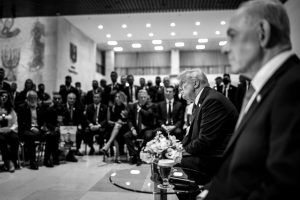
–Editorial
President Donald J. Trump has arrived in Sharm El-Sheikh, Egypt, for the second leg of his Middle East peace mission aimed at finalizing a Gaza hostages-for-ceasefire agreement—a move that could mark the most significant diplomatic breakthrough in the region in years.
Trump’s visit follows his earlier stop in Israel, where he addressed the Knesset and met with Prime Minister Benjamin Netanyahu to advance the first phase of the deal between Israel and Hamas. The trip, described by the administration as “a historic turning point for peace in the Middle East,” will conclude with meetings with Egyptian President Abdel Fattah el-Sisi to ensure full compliance with the ceasefire terms.
The peace initiative stems from Trump’s “20-Point Plan for Peace and Stability in the Middle East,” unveiled at the White House on September 29, developed in consultation with Arab and Muslim nations. The plan outlines a multi-phase roadmap to secure the release of all hostages, establish an immediate ceasefire, and lay the groundwork for Palestinian self-governance and eventual statehood.
The proposal includes a large-scale prisoner exchange, the demilitarization of Gaza, and the deployment of an international stabilization force to oversee reconstruction and governance. A transitional Palestinian technocratic body, under international supervision, would manage Gaza’s affairs during the transition period.
Support for the plan has poured in from France, Germany, Italy, Spain, Russia, Egypt, Turkey, Qatar, Jordan, and the United Arab Emirates, among others. Proponents have called it a pragmatic step balancing humanitarian relief with a long-term political solution.
Initially, Hamas rejected the demilitarization clause, labeling it an “infringement on Palestinian resistance.” However, in a major development on October 3, Hamas agreed to release all remaining hostages and transfer administrative control of Gaza to a Palestinian body of independent technocrats, though it stopped short of committing to full disarmament.
Trump warned that noncompliance by Hamas would result in “complete obliteration.” Within days, the parties reached an accord, signing the first phase of the deal on October 8.
Under the agreement, all living hostages held in Gaza are to be released within 72 hours in exchange for 2,000 Palestinian prisoners, including 250 serving life sentences. Israel agreed to withdraw its forces to pre-designated positions within Gaza, and the ceasefire officially took effect on October 10.
White House officials confirm that Trump’s current visit to Jerusalem and Cairo is focused on ensuring compliance with the ceasefire and advancing talks on reconstruction, governance, and security for Gaza’s next phase of recovery.
If fully implemented, the agreement could represent the first lasting ceasefire between Israel and Hamas since the conflict erupted in October 2023, following Hamas’s attacks that triggered a massive Israeli military campaign. Previous ceasefire efforts in 2023 and early 2025 collapsed amid renewed violence—but this time, hope for peace may be within reach.


